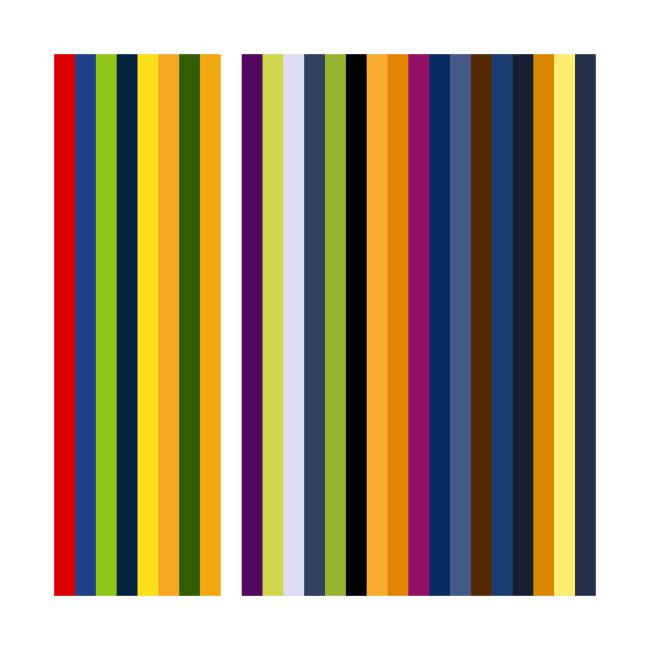
When Bernadette Sheridan hears your name, she does not think of the spelling in a traditional sense. Her mind isn’t trying to figure out what letter goes after the other to form the name. Instead, she hears the name in swaths of color using her own “color alphabet.”
Sheridan, 49, is a synesthete. Or, simply put, somebody with a neurological phenomenon called synesthesia.
For as long as Sheridan can remember, letters and numbers weren’t just shapes and signs. They were instilled with color in her mind. A is red, B is blue, C is lime green and so on. For instance, “Emily”– which happens to be Sheridan’s favorite name– is spelled with 5 intense, joyful colors: yellow, navy blue, white, periwinkle and light yellow.
” I don’t see [the letters] actually in color. I see the letter in whatever color it remains in, however in the back of my head, it’s glowing in my color,” Sheridan states. “It’s practically as if a curtain of color bars is available in the back of my head.”
She even sees the days of the week and months in color. Sunday is dark blue, Monday is red-orange, Tuesday is gray-blue and Wednesday is yellow. January is light blue, February is light pink, March is yellow-green and April is raspberry.
What Is Synesthesia?
Sheridan initially found out about her distinct sensory experience in 2002, while working as an art director for the New York City Daily News At the time, she was oblivious of the reality that other people didn’t experience words the very same method she did. While dealing with headings for the black-and-white pages of each problem, she would argue with her editor about words not being the right color.
” A word like killed is lighter and brighter,” Sheridan describes. “It has light letters, like I’s, L’s and E’s, but a word like murder is dark and foreboding. A word like slain has a red A right in the middle, like a knife. I would recommend words based on what I thought they appeared like. Obviously, [my editor] didn’t understand, and I didn’t comprehend that he didn’t comprehend.”
Then, one day, Sheridan’s editor gave her a post from the science section of the Wall Street Journal about synesthesia, a neurological condition in which one or more of the 5 senses, or other types of perception, crosses with another. It’s a type of sensory entanglement that can occur in a wide variety of combinations, but there are at least 10 known kinds of the condition. Some synesthetes can hear colors, feel sounds and see time as different points in space. People with the most common type, grapheme-color synesthesia, see letters as colors.
” I believed, ‘Oh my god, there’s a name for it!'” Sheridan remembers. “It resembles the day your world changes. … It offered me something to start looking at and discovering.”
Cross-talk Between Senses
Roughly 4 percent of the general population has some form of synesthesia. However since people often don’t understand they have the condition, scientists believe that the actual number may be even higher.
While the accurate system of synesthesia is still mainly unknown, the dominating hypothesis is that there is a genetic component that permits some individuals to have an increased cross-talk in between nearby areas of the brain that govern specific functions.
” It’s like two nations with porous borders that are talking,” states David Eagleman, a neuroscientist at Stanford University and leading scientist in synesthesia. “For instance, the areas of the brain that are involved in letters and those that are involved in colors happen to sit close to each other, so it’s thought that– for whatever reason– there’s more of a relationship in between them.”
In 2005, Eagleman released the Synesthesia Battery, an online test to help people examine whether they have synesthesia and what type. The website ultimately became the gold requirement for examining synesthesia and collected information from more than 40,000 rigorously-verified synesthetes.
Eagleman is operating in cooperation with associates in Europe to carry out a large genetic study of synesthetes. They found a hotspot on a particular area of chromosome 16, among the 23 pairs of chromosomes in human beings, however have not yet determined the significance behind it. Eagleman states he believes it will be a subtle variation that nevertheless has drastic repercussions.
” It’ll be something that changes things by 1 percent– some little modification in the confirmation of a neuroreceptor and your awareness is different,” he states. “Our awareness is extremely fragile, and all you need to do is alter the network a bit and you get a various experience. I think that’s what synesthesia is: You simply alter things by a little, small hereditary tweak and, unexpectedly, letters have color to them.”
While real synesthetes naturally have this unique quality, researchers believe there is some degree of conditioning by external stimuli. As kids with synesthesia are discovering to memorize sequences– such as the alphabet, numbers, weekdays and months– they associate them with colors that they’re exposed to as a built-in mnemonic device.
” If you have the genes for it and you’re trying to find out these arbitrary sequences, your brain reaches out and states, ‘This does not make sense,'” Eagleman describes. “It hooks things with a different home, like color, so it becomes easier to remember.”

Bernadette Sheridan’s color alphabet. (Credit: Bernadette Sheridan)
Seeing Color
Grapheme-color synesthetes, like Sheridan, all have their own special color alphabet, however some commonness exist. According to a 2015 research study released in PLOS One, Eagleman and his group took a look at 6,588 English-speaking grapheme-color synesthetes from their database to see whether or not synesthesia was affected by Fisher-Price’s brilliantly colored letter magnets. The sets, which were produced from 1971 to 1990, consisted of red A’s, orange B’s, yellow C’s and lime green D’s.
A pattern emerged in their findings. The research study discovered 6 percent of the total individuals had color-letter associations that matched the toy set. Amongst that population, 15 percent of those born during the pinnacle of the toy’s appeal, from 1975 to 1980, reported colors in agreement with the toy. On the other hand, nobody born five or more years before the toy was produced matched the Fisher-Price colors. The scientists discovered that grapheme-color synesthetes who were exposed to the alphabet set throughout youth were most likely to see comparable colors as the toys.
” What that taught us is that you can inscribe on particular things,” Eagleman states. “The factor most synesthetes probably seem to have a random alphabet is due to the fact that what you imprint on is quite random– whatever quilt you occur to have in your kindergarten classroom or whatever crayon you take place to get prior to you practice the letter C a million times.”
To better comprehend the neural paths of synesthesia, scientists are using advanced neuroimaging to study the phenomenon. Using MRIs to analyze the structural connectivity in synesthetes, some research studies have reported increased volume of gray matter in specific areas of the brain connected to color processing. These scientists have also experienced a chicken-or-the-egg dilemma: Were synesthetes born with additional gray matter, or did they develop it after since they utilized that part of the brain more than
non-synesthetes?
Other studies utilized functional neuroimaging, such as single-photon emission computed tomography (SPECT) and fMRI scans, to trace neural activity to specific functions. The main location of interest is the hV4 region of the visual cortex, which has actually been revealed to be more active in grapheme-color synesthetes. These findings are undetermined.
” As we improve imaging of the brain, which is occurring in genuine time, I think we’re going to have the ability to begin to draw out the pathways,” says Randall Wright, a neurologist at Houston Methodist Healthcare Facility. “We can speculate when paths are included based upon what the person is doing.”
The paucity of conclusive information is in large part due to the reality that the human brain is still one of science’s greatest secrets. With 86 billion nerve cells and 100 trillion synapses, we have actually only grasped the idea of the iceberg in comprehending the complexities of the brain.
” There are so many things at different levels that we do not learn about the human brain,” Wright says. “Studying synesthetes more can give us more insights into how the brain truly works.”
‘ What Color is Your Name?’
In January 2020, Sheridan launched an online synesthesia job called “ What color is your name?” that imagines people’s names as color obstructs based on how she sees them. She created it as a method to share her sensory experience with the general public.
” I want individuals who don’t have synesthesia to come to it and have a good time with it– to be able to state, ‘Oh, this is a brand-new way for me to understand how other individuals experience an overlapping of senses,'” Sheridan discusses.
Her website has helped raise awareness of grapheme-color synesthesia, and she hopes that more individuals will discover their own color alphabet.
” It’s just something that you know about yourself, but nobody ever asks you,” she says. “For a lot of individuals who do not understand they have synesthesia, that’s the way to figure it out. Ask your buddies a leading question. You could say to them, ‘What color is B?’ If they say it’s blue, they have synesthesia.”
Comments
Post a Comment